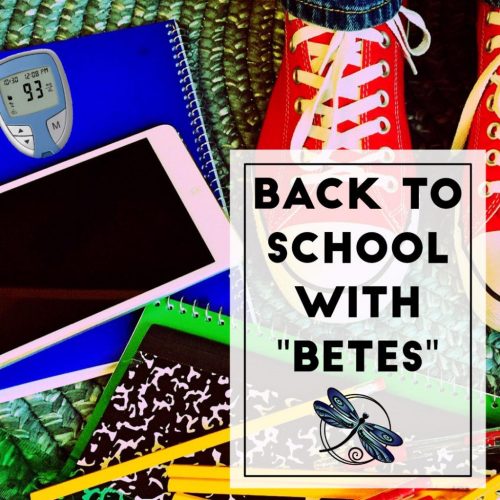For most parents of kids with diabetes, back to school time means ramping up your diabetes management game to all new highs! It is stressful anytime you upset your routing, and turning over your child’s care to someone else can really be hard. Just like with airplane oxygen masks, don’t forget to plan a little for your needs as you get your bundle of joy ready for their new adventures in their next grade! I have gathered some of the best tips I have encountered along the way intermingled with a few of my own.
Back to school with “Betes”
1. Identify your back up – who can you turn to when you are feeling overwhelmed? Find a person you can “dump on” so your child doesn’t see your fear and worry. Children are naturally better at going with the flow, until they see parents upset. You need to have support during this time too.
2. Have a “back to school” plan – make sure you have a checklist of all the tasks you need to do before school starts. Just having a list on paper, takes some of the worry out of your head.
3. Meet with the school nurse in advance – If you haven’t met the school nurse, creating a relationship with this most important resource is a big part of calming your fears. If you already have a relationship, it is good to check in and let them know about any changes or developments over the summer.
4. Download an app – if your child is old enough to use technology in school, consider using an app so they can enter blood sugars and you can monitor from home if you aren’t doing CGM
5. Preprint some “Carb cards” to put in your child’s lunch bag – Create a simple form that has date, amount of carbs in lunch and required insulin to cover. Fill out in the morning when prepping meal.
6. Gather supplies to have at school – Glucagon pen for nurses office, back up insulin, strips, syringes, pump & CGM supplies, ketostix or other medications.
7. Review and update your child’s Diabetes Medical Management Plan – It should include current insulin dosage, your child’s symptoms of highs and lows, what tasks they can self manage, how to adjust for physical activity, meal and snack needs, as well as provider’s updated contact info.
8. Create an Emergency Action Plan (EAP) – What to do with hypo or hyperglycemia?
9. Create a list of “who needs to know?” – Who will your child encounter that might need to know they have diabetes? Some ideas – crosswalk guard, bus driver, cafeteria worker, room mother and of course, their teachers.
10. Rehearse with your child – Create a list of scenarios that might occur at school and have your child role play their responses. Consider things such as kids asking about equipment or medication, what to do when they feel low, how to opt out of hi carb snacks, or what to say to a teacher if they need to visit the nurse.
11. Talk to your child about how they feel – This can be hard for them and they may not have the courage to bring up their fears and worries. If face-to-face feels too scary, create a private journal where they can write their questions, concerns, feelings or thoughts to you. They can leave this for you to read when they aren’t around, and you can write a response. Just one rule, unless it isn’t safe, no punishment from fessing up in the journal. It’s the communication you want, not perfection.
Enjoy
Lastly, take some fun pics and enjoy this time. Even though it may be stressful, it is such an important milestone and a door to many new adventures and growth!
http://www.diabetes.org/living-with-diabetes/parents-and-kids/diabetes-care-at-school/special-considerations/back-to-school-tips.html http://www.diabetes.org/living-with-diabetes/parents-and-kids/diabetes-care-at-school/school-staff-trainings/tips-for-school-nurses.html
https://www.cdc.gov/features/diabetesinschool/index.html


0 Comments